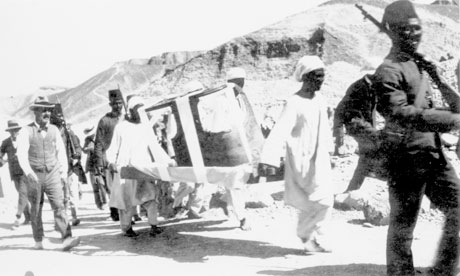
"Our sensations and astonishment are difficult to describe as the better light revealed to us the marvellous collection of treasures: two strange ebony-black effigies of a King, gold sandalled, bearing staff and mace, loomed out from the cloak of darkness; gilded couches in strange forms, lion-headed, Hathor-headed, and beast infernal; exquisitely painted, inlaid, and ornamental caskets; flowers; alabaster vases, some beautifully executed of lotus and papyrus device; strange black shrines with a gilded monster snake appearing from within; quite ordinary looking white chests; finely carved chairs; a golden inlaid throne; a heap of large curious white oviform boxes; beneath our very eyes, on the threshold, a lovely lotiform wishing-cup in translucent alabaster; stools of all shapes and design, of both common and rare materials; and, lastly a confusion of overturned parts of chariots glinting with gold, peering from amongst which was a mannikin. The first impression of which suggested the property-room of an opera of a vanished civilization."
These are the words of archaeologist Howard Carter, describing his first glimpse inside Tutankhamun's tomb after he discovered it in 1922. The treasures within had been undisturbed for 3,300 years.
This discovery is now one of the most famous in all of archaeology - the only intact royal tomb that has ever been found from ancient Egypt. But the details of what Carter found are surprisingly little known. In all, Carter found 5,398 items, so many that it took him 10 years to catalogue them all. Some, like Tut's iconic gold burial mask, are instantly recognisable. But the majority have never been properly studied and published, and are unfamiliar even to experts. Carter died in 1939, just seven years after his excavation ended, and before he could fully publish his findings. The sheer size and importance of his haul seems to have discouraged other scholars from tackling it.
The notes from Carter's excavation, including 3,500 densely-written note cards, more than 1000 photographs taken by Carter's colleague Harry Burton, as well as Carter's diaries and journals, are now held in the Griffith Institute in Oxford. I've just written this article in The Observer about an effort by Jaromir Malek, head of the Griffith Institute, to make all of these materials available online. He and his handful of staff have had to do it in their spare time because no one would fund the project, but after 15 years they have finally finished, and the last pieces will be scanned, transcribed and posted in the next few months.
The result is a really stunning website called Tutankhamun: Anatomy of an Excavation. You can browse the objects from the tomb - some of my favourites include this leopard-skin cloak with golden head and silver claws, this model boat, and this brilliant folding bed. Or you can search for a specific item - type in "mummy" for example (then click on "King's mummy") and you'll find 68 photos of Tut's mummy taken at various stages of the unwrapping process. I also love Burton's eerie photos of the undisturbed tomb.
Malek says he wants to put "moral pressure" on Egyptologists, to encourage them to study this immensely important collection of objects. Researchers still need to study the objects themselves of course, most of which are on display in the Museum of Egyptian Antiquities in Cairo. But the Carter archive includes information that can't be gleaned from looking at the objects today. He recorded exactly where each item was found within the tomb for example. And he saw them in the best possible condition - many of the finds, especially those made of organic material, have decomposed since they were removed from the tomb. Andre Veldmeijer of the PalArch Foundation in Amsterdam used the website in a recent analysis of the footwear found in Tutankhamun's tomb. One pair of leather sandals, delicately embellished with gold leaf and coloured beads, is shown perfectly preserved in Burton's potographs, yet Veldmeijer says his visit to see the shoes in the Cairo museum revealed an oozing black mess. He describes the online archive as "one of the best things in Egyptology".
But the site isn't just for researchers. Malek says he hopes project will bring the forgotten details of the tomb to as many people as possible. "We felt this was important because the discovery is so well-known," he says. "This doesn't belong to Egyptologists only, or even to Egypt only. Everybody should have the right to see what's there."
[Thanks to the Griffith Institute for the above photo, which shows Carter supervising the removal of objects from the tomb in 1922.]
UPDATE:
As well as my Observer article mentioned above, which discusses how researchers are now using the archive to make new discoveries about the tomb, you can also listen to my interview with Jaromir Malek on today's Guardian Science Weekly podcast.